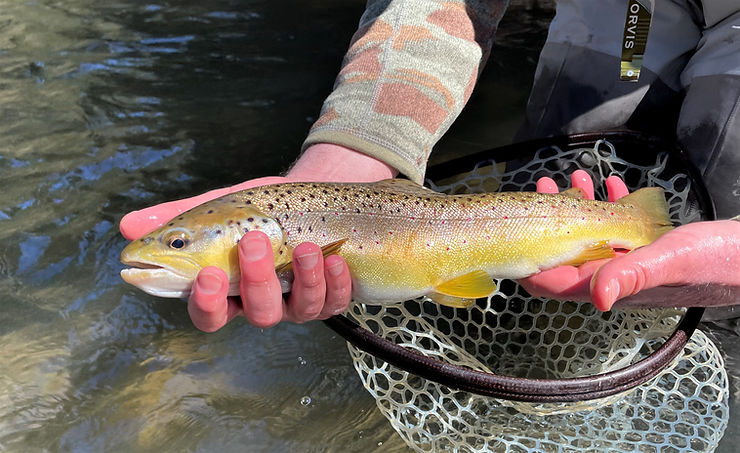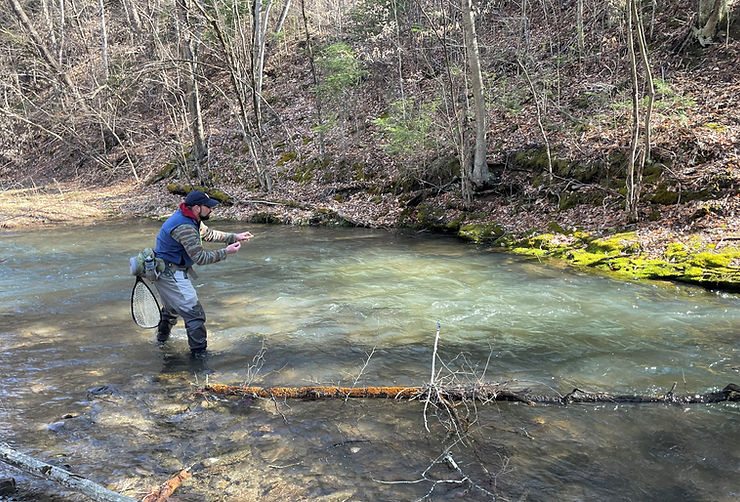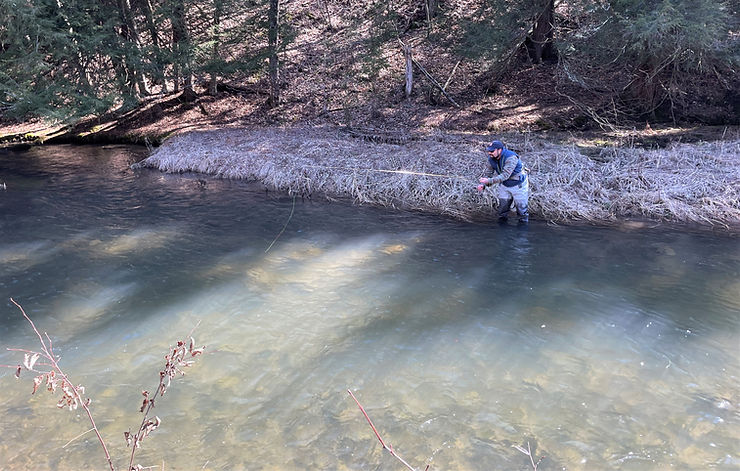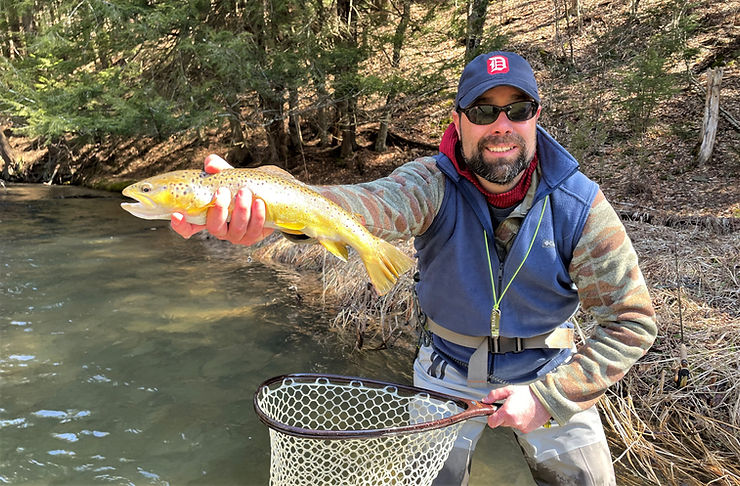5 Lessons Learned from Watching Others Fish

Back in March, I met my friend Justin Leidy on a local Class A stream. I met Justin last fall when he contacted me through this website and we soon began texting regularly about all things outdoors. I could tell through conversation that he was a talented fly fisher, and although this was the first time we actually met in person, I was looking forward to showing him one of my favorite waters.
What I didn’t realize was that ten minutes into the outing, I would break my fly rod in the most innocuous way, just by pulling out line to make a cast. With no spare in the truck, I was relegated to benchwarmer. But that was fine by me because it gave me a great opportunity to watch someone else fish for a change.
Overall, I’d rate the stream conditions as difficult. The water was high and cold. Brush and tree branches crowding the stream made presentations difficult, and the heavy current made it hard to fish midstream structure as well as keep the nymph on the bottom. But it’s a stream I know very well, and I had a feeling we’d get into something good in the couple of hours we’d planned to fish.
It turned out to be a great experience, and I learned a few things by watching Justin fish. Afterwards, we discussed my observations and he was able to offer some insights into his techniques. Although these tips and techniques are especially important for Euronymphing, they also belong in every fly fisher’s toolbox.
1. Get into position before making the first cast.
Wade into position rather than cast into position. Justin enjoys Euronymphing, which involves fishing a short, controlled line. He gets as physically close to the fish as possible without spooking them.
“I believe getting closer provides a better presentation,” Justin said. “I do occasionally spook fish, and sometimes I see them dart away. But overall, I think it’s worth it. I believe if you spook a wild fish and then remain in the same spot, they will return to their feeding lane. Also, spooking fish on highly pressured water is no big deal. Like the trout in Spring Creek. They are likely spooked most days of their lives. I can wade crazy close to Spring Creek fish and they go about their business. That doesn’t make them any easier to catch! Spring Creek trout are hard!”
My observation: I’ve seen more people spook fish by trying to cast too far to reach them rather than by just moving closer and getting into position. More importantly, taking the extra time to study the water and figure out where trout are likely to be stationed before even making your first cast will ultimately increase the number of trout you catch.

2. Keep everything in one seam.
Keep the fly and tippet in the same seam throughout the course of the drift. Allowing the fly and tippet to cross seams and currents inevitably results in drag.
“I’ve found that when I have everything in the same seam, my drift is slower than current at the top of the water column,” Justin said. “The water on the bottom is slower due to friction as it moves over the stream bed. This is where the fish are holding, and this is how I know I’m in the seam It’s high school physics class stuff!”
My observation is this. Justin’s approach was very methodical. Short, compact casts and drifts, running the rig through each individual seam. Sometimes, a huge mistake fly fishermen make is trying to cover everything at once. They want to hit all of the best lies in quick succession, but a shotgun approach is seldom the most efficient. Justin appeared to cover less water – or I should say, it took him longer to cover the water – but he did so very effectively.
3. Have patience and take time to figure out how to get the best presentation.
I was perhaps most impressed with Justin’s patience on the stream in these tough conditions, and it would’ve been easy to get discouraged after not getting a single bump the first hour or so. Instead, he changed fly weights and experimented until he found the right combination that would get the fly where it needed to be.
The other adjustment I watched Justin make was cutting down his tippet by 10-12” to target shallower water. The two browns landed were both holding in a shallow seam of lazy current just feet from the bank. He fished nearly upstream 15-20 feet and just a bit across at about 10 o’clock, using his reel hand to gently pull in leader as the drift approached. Shortening the business end of the rig, the tippet, inevitably resulted in fishing his single nymph shallower through the bank-side seam. This permitted him to direct the fly on a shallow course in and around the larger cobbles on the bottom.
That day, the air and water temperatures were downright cold, as this was March in Potter County. The bank water had been bathed in early spring sunshine, likely bringing the water temperature up a few degrees. Shortening his tippet provided the ability to gain better contact initially and control the drift in this shallow water to where the fish were holding.
“Sometimes it feels like I spend more time changing flies to find the right size than actually fishing,” Justin said. “But Euronymphing is all about the weight of the fly and choosing the one that’s going to provide the most natural drift.”
My observation: The trout aren’t going anywhere. It’s not a race to catch them. Spend the extra few minutes thinking through the situation and finding the right presentation. Eventually, this paid off big time when we came to a pool that has historically produced some very nice trout. Justin landed a beautiful wild rainbow followed by a 14-inch wild brown and a 17-inch wild brown. All three fish were absolutely gorgeous.

4. Rest the water between catches.
Catching a nice fish is exciting, especially when it’s in difficult conditions. However, sometimes it’s good to take a breather between catches and let the water settle a bit. Let any fish in the pool get back to feeding again and forget about all that thrashing that just took place.
“That particular day, I think I rested the pool without even realizing that I was resting the pool,” Justin said. “We were just so excited and wanted to take time appreciating each fish.
“During a hatch is a different story, though,” Justin added. “When trout are truly keyed in on surface feeding, I don’t think resting the pool is even necessary. Fish become obliviously catatonic. When the stream surface turns into a jacuzzi of rises, keyed-in fish can actually be really hard to spook.”
My observation: Some of my best days with the highest catch totals have come when I played it cool and let the pool rest for a few minutes between each fish. If a trout sees that every time a line comes by, one of the other trout in the pool starts thrashing and disappears, it won’t be long until that fish ignores the presentation, or even spooks at just the sight of it.

(Photo: Justin with a hard-earned, beautiful 17-inch wild brown trout, his best wild brown to date. This is the reward for doing all of the little things right.)
5. There is something important to be said about fishing with a friend.
A friend on the water provides a whoop of congratulations and a celebratory fist bump over a job well done. But everything in nature has balance, and for every great day on the water usually comes one that will humble your ass — even if in the form of a broken fly rod!
Fishing solo is great training. It provides increased focus on the task at hand. There are no distractions present, just you, the water and the fish. But sometimes it’s nice to powwow with a friend afterwards for a deeper dive into what was working or what was not. This, I think, is where the real learning begins.
Almost all of the tactics we commonly employ are based off of something that someone else has already innovated. But we all have different teachers. We draw inspiration from different places, different books, and media of all types. In a way, when you’re watching someone fish and learning from them, you’re also learning from the people that they have learned from.
In that regard, a single angler can become a window to all of those past innovators who’ve come before us. This is what connects us as fishermen, hunters, outdoorsmen, and so on. We learn these skills, add our experience and our passion, and then pass them on.
Did You Enjoy What You Just Read?
Stay up to date with the Dark Skies Fly Fishing monthly newsletter for free and receive the latest posts in fly fishing news, tricks, tips, and techniques, stream reports, as well as updates on new flies added to the Online Store and exclusive discounts!
Sign Up Now

I’m jealous, William, that you spent time on the water with Humphreys! Hell of an experience. He is a fly fishing legend, and a legend not just here in Pennsylvania. His fishing abilities transcend our state’s borders.
Good advice, especially the keeping it in one seam. Last week I fished a mop fly for the first time. The water was clear and it was amazing how many times I was not getting a natural drift with one of my typical presentations. Later I had my wife fishing in a small pool I knew held at least 12 – 20 stocked rainbows. After she caught a beautiful native brook trout, I took a turn. She was fishing with an indicator and the drifts looked good, but I could tell something wasn’t right. So on my drift I got a little closer and essentially just had the indicator on the water, which is essentially to me Euro style or tight line nymphing. On the first drift I got one of the stocked rainbows in the same place my wife had covered about 20 times. Also the mop fly did not catch anything for me.
Thank you, William, for your response. I agree with you that fishing an indicator on a tight line using a traditional fly fishing rig can provide similar presentations as Euronymphing. There exists differences in the details between tight lining and Euro-style contact nymphing. But, these differences can become remarkably technical and tedious. And, speaking candidly, irrelevant when catching fish. In most things, there is more than one way to skin the cat!
Legends such as Harvey and Humphreys innovated tight line nymphing techniques years and years ago. Long before Euronymphing was a thing! As Ralph explained above, we all learn for others’ approaches and innovations and adapt them to fit our needs and skills and abilities on the water.
Yes, I agree there a many ways to do essentially the same thing and some are better in certain cases. I had the privilege to fish with Joe Humphrey several times and he was amazing. I was a tight liner for years, but my eyes are not as good now. The indicator really helps me, but I am trying a Euro rig as I like the contact experience. My main fishing partner who it seems can catch a trout in a mud puddle sticks to the indicator as he says and it is true for him, “I catch all the trout I want”.
Amen in the part about eyes not being as good as they used to be! I’m there! Sounds like you and I fish the indicator in similar ways, William.
That’s fantastic that you were able to fish with Humphreys! I spent a good day with him just chatting about fly fishing, but I never got on the water with him. You’re very fortunate.
Yes, I watched him fish Slate Run, just watched. Catching fish in places that looked to me at the time to be unfishable. Our cousin John Mosco took the Penn State course from him. I also fished Yellow Breeches, Pine and Little Pine Creek with him as part of kind of a school seminar for a pharma company. I was the “guest” of my brother in law who is a doctor. He became friends with Joe and would occasionally visit him and fish.